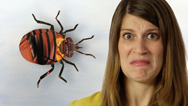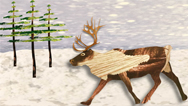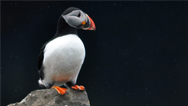Sea Cucumber Butts
- By Anna Rothschild
- Posted 01.12.17
- NOVA
Meet the most versatile butts in the animal kingdom in this episode of Gross Science.
Transcript
Sea Cucumber Butts
Posted: January 19, 2017
Sea cucumbers have a really strange relationship with their buttholes.
I’m Anna Rothschild, and this is Gross Science.
To begin, let me just clarify that sea cucumbers don’t exactly have a butt in the human sense. They have something called a “cloaca” which is kind of an all-purpose opening. Lots of animals, including many birds, have a cloaca, which they use to pee, poop, and in some cases, mate.
But the sea cucumber takes this whole “all-purpose” thing a little further. To begin with, they actually breathe through their butts. Rather than using lungs, sea cucumbers take in oxygen by flushing water over organs called respiratory trees. And how does the water get into the sea cucumber? It’s pumped in through the backdoor by the muscles of the cloaca.
Sometimes bits of food get pumped in, too. And at least some sea cucumbers don’t let those bits go to waste—they can eat with their butts, as well! Their respiratory trees possess some intestine-like properties, and can absorb nutrients. To be clear, sea cucumbers probably prefer to eat with their mouths. But they won’t turn down a tasty morsel if it happens to float in through the cloaca.
Finally, and perhaps strangest of all, small skinny fish called pearlfish actually make sea cucumber butts their home. Many pearlfish live peacefully with their sea cucumber hosts. They’re what’re called “inquilines,” which means that they’re organisms that live inside of or in the home of another species, but don’t hurt it. However, some species of pearlfish are actually parasitic and eat the sea cucumber’s reproductive organs along with other tissue.
Now, sea cucumbers actually have a bunch of defense mechanisms to avoid predators and parasites. One is the ability to expel and regenerate their internal organs—and for more on that, see my previous video on the subject. But they also have chemicals called saponins in their bodies, including in their Cuvierian tubules, which are sticky strings that sea cucumbers shoot out of their cloaca when they’re attacked. Saponins usually burst open the cells of the would-be predator or parasite. But pearlfish aren’t affected. And scientists think it might be because they’re covered in a relatively thick layer of mucus, which protects them from the toxins. As a side note, Harlequin crabs, which also live in and on sea cucumbers, may actually be attracted to their hosts by those same chemicals.
Finally, sea cucumbers may have one more defense mechanism. Some of them have structures called anal teeth, possibly to keep the pearlfish out—though, no one knows for sure if that’s really what anal teeth are for. In many species, the fish can slip in anyway.
Long story short, sea cucumbers are really just gifts to curious people everywhere. The more I learn, the more I’m impressed with these guys...and with their butts.
Ew.
Credits
PRODUCTION CREDITS
- Host, Writer, Editor, Animator
- Anna Rothschild
- Camera, Sound
- Zachary Hoffman
- Welcome to the Circus a
- Music Provided by APM
- Original Footage
- ©WGBH Educational Foundation 2017
FOOTAGE AND IMAGES
- Images of Sea Cucumber Butts
- By Klaus M. Stiefel
- Graceful pearlfish (Encheliophis gracilis) living inside sea cucumber (Bohadschia argus) on reef, West Papua, Indonesia
- Getty Images/BBC Natural History
- A common, large sea cucumber (Bohadschia argus) is easy to identify due to its distinctive pattern. This species can extrude sticky defensive threads called cuverian tubules.
- Shutterstock/Ethan Daniels
- Cloaque Femelle
- Wikimedia Commons/Au Domaine des 3 Coqs
- Swimming Crab - Lissocarcinus Orbicularis on Sea Cucumber
- Wikimedia Commons/Prilfish
- Lissocarcinus orbicularis LandaaGiraavaru
- Wikimedia Commons/MDC Seamarc
- Pseudocolochirus axiologus
- Wikimedia Commons/Marrabbio2
- Pearsonothuria graeffei bouche
- Wikimedia Commons/Frédéric Ducarme
SFX
- Cockroaches
-
Freesound/StateAardvark
(used with permission from author) - Squeak Pack/squeak_10
- Freesound/Corsica_S
- Produced by WGBH for PBS Digital Studios
POSTER IMAGE
- Sea Cucumber Butt
- By Klaus M. Stiefel
Sources
Want more info?
(Primary Literature) The anus as a second mouth: anal
suspension feeding by an oral deposit-feeding sea
cucumber:
http://bit.ly/2ibnzXa
(Primary Literature) Mechanisms involved in pearlfish
resistance to holothuroid toxins:
bit.ly/2ibg4z8
(Primary Literature) When a repellent becomes an attractant:
harmful saponins are kairomones attracting the symbiotic
Harlequin crab:
http://go.nature.com/2ibltGv
Related Links
-

Gross Science
Bizarre stories from the slimy, smelly, creepy world of science.
-

Sea Cucumber Evisceration
Sea cucumbers can expel their internal organs and then regrow them.
-

The Secret Lives of Reindeer
Meet the real Rudolph, from bloody antlers to super vision.
-

Can Bird Poop Make Clouds?
Bird poop could help clouds form, keeping our planet a little bit cooler.

